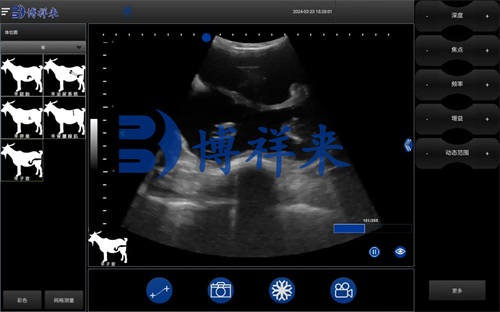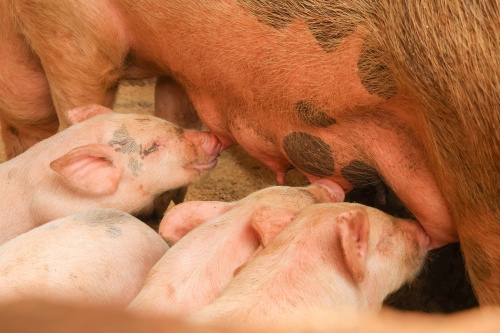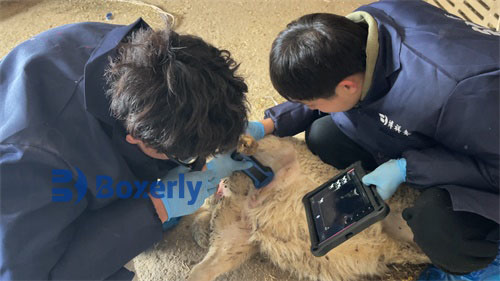For sheep farmers and animal reproduction specialists, understanding ram fertility is critical for maintaining consistent flock productivity, especially in seasonal breeding systems. The reproductive capacity of rams is not static — it fluctuates throughout the year, influenced by environmental, hormonal, and physiological factors. Modern animal husbandry increasingly relies on advanced tools to monitor these changes accurately, and among them, Veterinary ultrasound technology has emerged as one of the most reliable, non-invasive, and insightful methods. In this article, we’ll explore how animal ultrasound scanners are being used to assess seasonal variation in ram fertility, and why this approach is gaining widespread adoption internationally.

Seasonal Patterns in Ram Reproduction
Sheep are typically seasonal breeders, with most breeds displaying a peak reproductive period in the fall and early winter. This seasonal breeding cycle is governed primarily by changes in photoperiod — the length of daylight hours — which influence the secretion of melatonin and subsequently regulate reproductive hormones such as testosterone and luteinizing hormone (LH). Rams, being the male counterpart in this cycle, experience fluctuations in testicular size, semen quality, and mating behavior in response to these hormonal shifts.
During the breeding season, rams exhibit maximal testicular growth, high sperm concentration, robust libido, and increased fertility. In contrast, the non-breeding season often brings a reduction in testicular volume, lower sperm production, and sometimes compromised semen quality. This dynamic presents a management challenge: how can farmers monitor and optimize ram fertility throughout the year to ensure consistent lamb crops?
The Role of Ultrasound in Reproductive Assessment
Veterinary ultrasound scanning has revolutionized how we evaluate reproductive health in livestock. Traditionally, ram fertility was assessed primarily through physical examination and semen analysis — methods that can be subjective, time-consuming, and sometimes stressful for the animal. Ultrasound, by contrast, offers an objective, real-time, and non-invasive alternative that can provide detailed insight into testicular and reproductive organ status.
In particular, B-mode (brightness mode) ultrasound imaging allows veterinarians and farmers to visualize the internal structure of the testes, scrotum, and accessory reproductive organs. By regularly monitoring these structures, they can assess changes in tissue density, volume, and echotexture that correlate with fertility potential.

Ultrasound Evaluation of Testicular Morphology
The testicles are the primary reproductive organs in rams, responsible for both sperm production and hormone synthesis. Several parameters can be assessed via ultrasound to evaluate testicular health:
Testicular volume and diameter: Larger testicular size generally correlates with higher sperm production capacity. Seasonal shrinkage in size can be precisely monitored to predict reductions in fertility.
Parenchymal echotexture: Homogeneous echotexture indicates healthy, active seminiferous tubules, while heterogeneity may suggest fibrosis, degeneration, or subclinical pathology.
Epididymis and vas deferens assessment: These structures can also be scanned to detect potential blockages or inflammation affecting sperm transport.
In my practical experience working with rams throughout different seasons, ultrasound scanning provides early indicators of declining fertility long before changes in mating behavior or semen quality become apparent. This enables timely interventions, such as nutritional adjustments or the use of hormone therapies, to mitigate seasonal fertility dips.
Hormonal Correlations Detected by Ultrasound
Ultrasound findings often correlate closely with hormonal fluctuations. During the breeding season, increased testosterone levels stimulate both libido and testicular enlargement. The denser parenchymal tissue visible on ultrasound often reflects active spermatogenesis. In contrast, during off-season periods, reduced testosterone levels lead to testicular atrophy, which is easily observed as a reduction in testicular volume and echogenicity.
Researchers in Europe and North America have extensively documented these patterns. For example, a study conducted at the University of Zaragoza in Spain demonstrated a clear correlation between daylight length, testosterone concentration, and testicular volume measured via ultrasonography (Carcangiu et al., 2020). Such studies reinforce the value of ultrasound as a practical tool for field assessments.
Global Adoption and Practical Applications
The global livestock community has increasingly adopted ultrasound scanning as part of routine reproductive management. In countries with large sheep industries such as Australia, New Zealand, and the UK, portable veterinary ultrasound devices are now standard equipment on many farms. These devices, such as the highly rated BXL-V50 veterinary ultrasound scanner, offer high-resolution imaging, are waterproof and durable, and allow real-time assessments even in field conditions.
Here’s how farmers and veterinarians internationally are leveraging ultrasound to manage ram fertility:
Breeding soundness evaluations: Before the breeding season, ultrasound can confirm that rams are physically ready and fertile.
Selection of replacement sires: Young rams can be assessed for testicular development and potential fertility.
Monitoring after illness or stress: Testicular damage from fever, nutritional deficiency, or injury can be detected early.
Post-breeding evaluations: After mating, rams can be scanned to ensure reproductive organs have not been compromised.
Benefits of Ultrasound in Seasonal Ram Fertility Management
Several key benefits make ultrasound an indispensable tool for modern sheep breeders:
Non-invasive and stress-free: Ultrasound does not require sedation or invasive procedures, minimizing stress on the animal.
Real-time, immediate results: Farmers receive instant feedback on the reproductive status of their rams.
Early detection of issues: Subclinical problems that may not yet affect semen quality can be detected through structural changes.
Cost-effective over time: Compared to repeated laboratory tests, ultrasound offers a more sustainable solution for continuous monitoring.

Case Example: Managing Seasonal Rams on a British Farm
On a mid-sized sheep farm in Cumbria, England, I worked with a local veterinarian to introduce routine ultrasound scanning for the farm’s 40 breeding rams. Using a portable ultrasound scanner, we began bi-monthly evaluations starting six months before the scheduled breeding season.
Initially, we observed a gradual increase in testicular volume and improved parenchymal consistency as the days shortened — classic signs of rising fertility. One ram, however, displayed significant asymmetry between his two testes and irregular echotexture. Further investigation revealed a partial blockage in his epididymis, which would have severely affected his fertility. Thanks to the early detection, the farmer replaced him with a backup ram before the breeding season began, ensuring flock productivity was not compromised.
This proactive management strategy has since become routine on the farm, greatly improving reproductive efficiency and reducing unexpected fertility failures.
Understanding the Physiological Basis for Seasonal Variation
The primary driver behind seasonal reproductive changes in rams is melatonin secretion from the pineal gland. As day length shortens in the fall, melatonin secretion increases, which in turn stimulates the hypothalamic-pituitary-gonadal axis to increase testosterone production and support active spermatogenesis. Conversely, long daylight periods in spring and summer suppress this pathway, leading to reproductive quiescence.
While this biological rhythm is hardwired into many sheep breeds, selective breeding and intensive management have modified these patterns in some commercial flocks. Nevertheless, even breeds less sensitive to photoperiod still benefit from ultrasound monitoring to optimize breeding outcomes.
Limitations and Considerations
While ultrasound provides valuable insight, it should be seen as part of a comprehensive reproductive management program. Limitations include:
Operator dependence: Image quality and interpretation rely heavily on the skill and experience of the operator.
Complementary to semen analysis: Ultrasound evaluates organ structure, but not directly sperm function or genetic quality.
Cost of equipment: While decreasing, the initial cost of high-quality ultrasound scanners may still be a barrier for small farms.
Despite these limitations, ongoing technological advancements, such as automated image analysis and portable handheld scanners, are making ultrasound more accessible and user-friendly worldwide.
The Future of Ultrasound in Sheep Breeding
Looking forward, the integration of artificial intelligence (AI) with ultrasound imaging holds promise for even more precise fertility assessments. AI algorithms can assist in quantifying testicular structures and identifying subtle changes that may not be visible to the human eye. This could help standardize fertility evaluations across farms and regions, further optimizing breeding outcomes.
Additionally, combining ultrasound data with genetic markers and hormonal profiles could lead to highly individualized fertility management plans for each ram, maximizing genetic gain while ensuring animal welfare.
Conclusion
In an era where precision livestock management is becoming essential for economic and ethical sustainability, veterinary ultrasound technology offers an unparalleled window into ram reproductive health. Seasonal variation in ram fertility, once challenging to monitor and predict, can now be accurately tracked through non-invasive, real-time imaging.
By adopting ultrasound scanning as a routine part of fertility assessments, sheep producers around the world are better equipped to manage breeding programs proactively, select superior sires, prevent fertility losses, and ensure consistent lamb production year after year. Whether on large commercial operations in Australia or small family farms in Europe, ultrasound is transforming how we understand and optimize ram fertility in seasonal breeding systems.
Reference Sources:
Carcangiu, V., Mura, M. C., Daga, C., & Vacca, G. M. (2020). “Seasonal changes in testicular size and testosterone concentration in rams monitored by ultrasonography.” Small Ruminant Research, 183, 106035.
Salamon, S., Maxwell, W. M. C. (2000). “Storage of ram semen.” Animal Reproduction Science, 62(1-3), 77-111.









